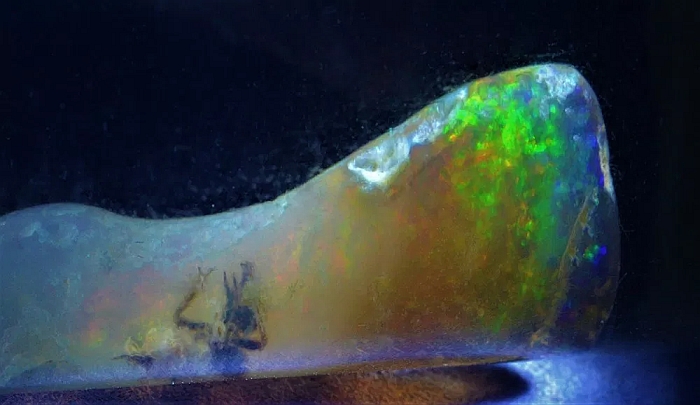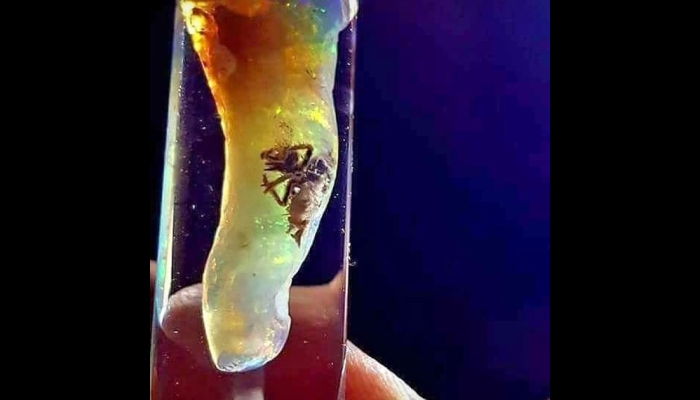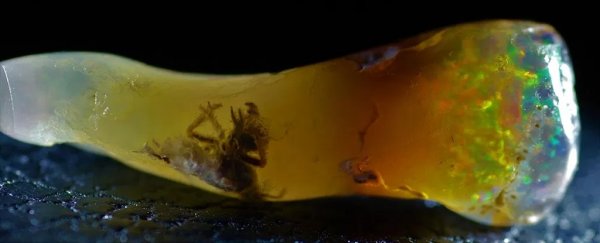The markets of Southeast Asia are common places to find the fossils of insects, embedded in amber millions of years old. But last year, gemologist Brian Berger found something much more rare and astonishing.
The piece he bought features an insect inclusion, except it's not preserved in amber - the lithified resin of ancient trees - but in precious opal, a mineraloid whose formation is still largely a mystery.
"As evidenced in the photos, you can see what appears to be a complete insect encased beautifully inside," Berger wrote in a blog post for Entomology Today.
"Upon close inspection, the insect appears to have an open mouth and to be very well preserved, with even fibrous structures extending from the appendages."
 (Brian Berger)
(Brian Berger)
The Gemological Institute of America has studied the specimen in detail, and issued a report and certificate authenticating the find. According to the report, it's a real (as opposed to synthetic), unaltered, untampered precious opal, with a genuine insect inclusion.
It's not, the report states unequivocally, a hoax. What you're looking at is the real deal.
Which raises the question: how on Earth did it even come about?
"If it is an opal replacement of amber, it challenges our current understanding on the formation of opal," geologist Ben McHenry, senior collection manager of Earth sciences at the South Australian Museum, told ScienceAlert.
"I think this specimen might actually be quite pivotal in our understanding of how opal forms."
Our current theories about opal formation require water with a high silica content, and cracks and cavities. In Australia, where most of the world's opals can be found, acidic groundwater dissolved the silica in rocks, and washed it down into the sediment.
As the pH level of the water re-stabilised, the silica was deposited in cavities in the rock - including pockets left when the acidic water dissolved the calcium carbonate of buried bones (this is how we get opalised fossils).
In Indonesia, where Berger's acquisition came from, most of the opal is volcanic, which occurs when volcanic fluid cools down. Water in the melt flows down and, like sedimentary opal, deposits silica into cavities.
You can no doubt see the conundrum: in both cases, a hollow cavity is required for the siliceous water to drain into. Amber is not a cavity.
"It's a freak," McHenry said. "But perhaps the process of amberisation is similar to the process of opalisation. It's thrown another spanner in the works, but that's science and that's how it works."
Based on the pictures, he believes the specimen is real. He also suggests that one way it may have formed could have something to do with opalised wood, which is plentiful in Indonesia.
Since wood is the source of amber, perhaps the insect-in-amber had been nestled inside a crevice in a piece of wood before opalisation took place.
"I presume that this piece of amber, or what would once have been amber, had the insect in it, and somehow we've had an ionic exchange as these highly siliceous volcanic fluids pass through the sediments, cook them and deposit the opal," he told ScienceAlert.
 (Brian Berger/Instagram/@velvetboxsociety)
(Brian Berger/Instagram/@velvetboxsociety)
Berger, who purchased the unusual stone for his private collection, is looking to work with scientists to study it in detail.
"The opalised amber is just the initial theory currently and through more research we are hoping to determine more about the formation process," he told ScienceAlert.
And let's not forget the insect inclusion itself. Amber takes millions of years to turn to stone (much of the substance sold as amber is actually copal, the mid-point between resin and amber), and opal also takes a long time to form and solidify, so that unidentified insect could be very old indeed.
"If the process of formation is correct, from tree sap with an insect through a sedimentary process, to copal, to amber, to opal it could mean the insect has the possibility to be one of the oldest ever discovered," Berger said.
Research is currently being undertaken on the specimen to try and learn more about how it was formed.
Berger is also keen to work with an entomologist or palaeontologist to try to learn more about the insect inside; any interested parties can get in touch with him via his email.
We can't wait to hear what they find.
